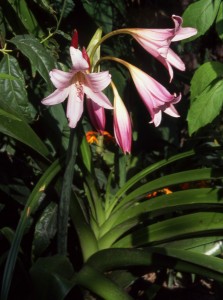
Every greenhouse should have at least one from this small genus of glorious plants whose blooms so closely rival lilies. For Crinums are robust, reliable and truly sumptuous display plants in either the greenhouse or plant conservatory. They are also excellent flowers for cutting and worth growing for that alone.
The blooms of C. xPowelli blend well with pink Nerines which come into flower at much the same time and enjoy very similar conditions though the Nerines are a tad less tender. The Crinums have large long necked bulbs, protruding above the compost and are slightly tender so require§ at least a frost free greenhouse though not needing great heat. The tougher species such as C. Moorei, and more often it’s superb hybrid offspring C. x Powelli, may occasionally be found surviving outdoors in some sheltered sunny spot, often near the south coast.
Generally though most Crinums are safer in a warm greenhouse or sunny conservatory. Which is not surprising as this genus comes from sub-tropical regions of the southern United States, South Africa and Eastern Australasia. Out there Crinums are often come across in hotel gardens where they give good long displays for very little trouble. Back here under cover they are not difficult and unlike some bulbous plants can be very long lived yet remaining fully productive.
Crinums are not particular as to compost though preferring it to be well drained, and like most bulbs they love to have extra leaf mould included. As these can make quite large plants (metre plus long glossy leaves when happy) they need big pots or preferably tubs (up on a stand so the leaves hang), and not planting too deep, ideally with their nose protruding from the compost. But after that they’re easy to look after, relatively pest and disease free (though slug or snail damage to their leaves is rather unsightly and so should be guarded against), and such good value.
These are attractive, architectural plants with gorgeous foliage and striking scented blooms. Even whilst dormant their large bulbs protrude up out of their compost to give some interest. When the long dark green strap like leaves emerge these make the plant a most imposing display. Then in summer tall flowering stems shoot up carrying sprays of impressive funnel shaped perfumed blooms. These flowers coming in light or dark pink or creamy white are remarkably lily like in appearance. Each species carries a heavenly perfume, with some quite spicy, and all are most noticeable at night as these attract night flying moths in their native habitats.
Crinums final virtue is most bloom on for a long period with more fresh buds opening daily (thus they look better if you nip off the older flowers as these shrivel). Most oddly these are distantly related to daffodils though you’d never guess it. And they’ve never acquired an English common name but then neither have Fuchsias.










